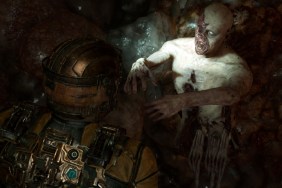Everything you know is wrong.
Professor Layton and the Curious Village looks like a calculatedly quaint throwback to the heyday of point-and-click adventures, thoroughly peppered with one brain teaser after another. Closer inspection reveals it to be exactly that (sometimes, things are what they seem…but as you’ll soon see, only sometimes).
Based on the Layton Kyoju games, this is the first appearance of the Japanese series in the North American market, which means that stateside gamers just might see the release of the series’ follow-up games in the future.
[image1]I’m certainly not baggin’ on games, as this can be asked about most any medium, but how often does a game make an immediate, notable change on your outlook on everyday out-in-the-sunshine meat-space life? In my case, this quiet, unassuming DS title has managed to do just that. I’ve been continually surprised (and even something like shamed) over the last few days at just how much it’s possible to take for granted. Professor Layton and his can-do sidekick Luke have set that at least a little closer to rights.
The game is set in a gentlemanly and deliberately ‘Olde-World’ universe that mostly seems to straddle the line between the Victorian and Edwardian eras, with some fuzzy and increasingly glaring anachronous intrusions, like an ‘automobile’, combustion-engine or otherwise, in an opening animated cinematic. Professor Layton and the Curious Village follows the journey of the titular, top hat-wearing puzzle-solver and his good-natured boy sidekick in the puzzle-obsessed, pseudo-kinda-Franco-whoozit town of St. Mystere.
Layton and boy-wonder Luke must solve the mystery surrounding an eccentric magnate’s last will and testament – that, and to learn just what the heck the ‘golden apple’ mentioned therein actually is and why people seem to be disappearing. In fact, the whole town is a quirky hornet’s nest of brain-teasing puzzles. And some of them can be – pardonnez mon français – real bitches.
You’ll be challenged, begged, or otherwise obliged to solve one puzzle after another by every townsperson you run into. Individual puzzles rarely have any meaningful connection to the overarching mysteries of St. Mystere’s larger secrets, and the segues between talking to townsfolk and suddenly facing a brain-teaser usually aren’t subtle at all. It’s often something like, “These mysterious abductions certainly are frightening! Say, that candle reminds me of puzzle!” And there you go, into the puzzle itself, returning to the main point-and-click exploration mode as soon as you’ve either conquered the puzzle or given up… for the time being.
The puzzles come straight from the brain of Chiba University’s Professor Tago Akira, author of the Head Gymnastics series of puzzle books (also known as Mental Gymnastics), which are extremely popular in Japan. If you’re any kind of puzzle-person, you can guess the basic drill: Rearrange X pattern of matchsticks in Y number of moves; separate these piggies from those piggies with the minimum number of straight fences; get precisely 5 liters of milk into a pitcher using only 10-, 7- and 3-liter pitchers of milk; determine the next letter in the series; and so forth. Thankfully, you can use the stylus on the lower screen to scrawl helpful diagrams or notes to yourself in the margins, should you need a little visual backup on any given problem.
[image2]If you get really stuck, you can spend ‘hint coins’ to get up to three increasingly blatant nudges toward the solution of any one puzzle. Even at hint #3, though, you’re rarely flat-out given The Answer, even if some of the final hints come awfully close. There are easy-to-find puzzles all over the place (just talk to any NPC on the streets), and sometimes you’ll have to solve one particular puzzle or another to advance. There are also good number of hidden ones which you will only find the old-fashioned way: by using the stylus on every possible portion of every possible exterior and interior location.
There are also extra hint coins hidden throughout the world in barrels, lampposts, wall-niches and tons of far-less-obvious locations. Even animals wandering the streets or buildings off in the far distance in locked areas, can yield new puzzles or hint coins. Check everything and check it again should you revisit a location – things can change over time, after all.
St. Mystere looks like something out of a Japanese anime with a temporally unspecified, European bent – Miyazaki-san would own it – and most aspects of the presentation reflect a romantic, nostalgic longing for an era of tophats, relative technological innocence, and the simplicity of a more polite time. Even a murder investigation is conducted with a measure of stuffy decorum. There’s not a lot of variety to the background music, but it’s generally a suitably old-world soufflé of European-sounding accordions and flutes, and some soothing, tinkly, find-your-thinking-place music.
There are a few stylistic elements that might yank you out of the pseudo-nostalgic world and back to our unpleasant present (like that 1979 Lincoln penny lurking in Christopher Reeve’s pocket). They include scattered bits of off-era dialogue (“Look at gramps bust a move”) and anachronistic references (car parking lots, televisions, and digital-display technology) in some of the puzzles themselves. Nostalgia is sweet; reality is a sharp stick in the mind’s eye.
The good news is that, for the most part, the puzzles work, and they’re truly challenging – and in some cases, truly eye-opening. There will be times when you are dead certain that a puzzle is either impossible, too hideously complicated to be worth your time, too subjective, or simply presented so poorly that it’s not solvable… And then, when you finally get the Epiphany (or break down and pay the hint-coin fee), you’ll see that the solution was so damned simple and right-in-front-of-you obvious that a Jerry Springer guest might have sussed it. A retarded Jerry Springer guest.
Unfortunately, the quality of the puzzles is not completely ‘even’. You actually will encounter the occasional puzzle that really is too subjective, too vague, or just presented so damned badly that it doesn’t come off as challenging but as lame. Sometimes these are ‘trick’ questions, which rely on the player not reading the premise of the puzzle closely enough – trick questions are okay, of course, but they need to be impeccably thought-out and presented.
[image3]The puzzles work best when they represent a situation that can be manipulated, or visually, geometrically, or mathematically represented. Less so, when it’s a hypothetical, which-of-these-people-is-lying sort of problem, or a “common sense” sort of solution. It’s unlikely that these rare defects in puzzle quality are a result of localization, which is superb throughout. They just happen to be, you know, wrong – thankfully, they’re vastly in the minority here.
In addition to the individual, numbered puzzles, there are some sub-challenges tucked into Professor Layton’s traveling chest. They involve the piece-by-piece construction of something-I-won’t-tell-you as players find individual items: a painting that is gradually put together from scraps that must be properly placed and rotated like jigsaw pieces; and even the layout of furniture and other elements added to Layton and Luke’s rooms at the inn. The chest also contains a log of all mysteries and puzzles the player has solved to date.
Finally, Professor Layton players can download new puzzles via their Nintendo Wi-Fi connection on a weekly basis. It’s a nice touch, though it doesn’t quite counterbalance the lack in ‘replay’ value. Barring a sudden, cataclysmic onset of Alzheimer’s, once you know a puzzle, you know it. But you can at least take the puzzles you’ve already bested and impose them on those who haven’t played them yet. You, dear reader, will surely feel stupid at least once or twice during the course of this game… so why shouldn’t your friends? Spread a little sunshine. It’s only gentlemanly.
-
Adventure-styled puzzle game
-
Superbly localized
-
Charming 'Olde-World' presentation
-
Downloadable new puzzles
-
Good range of challenges
-
Some vague and subjective puzzles
-
Some flat-out poor puzzles
-
Near-zero replay value
-
Some puzzle 'retreading'











